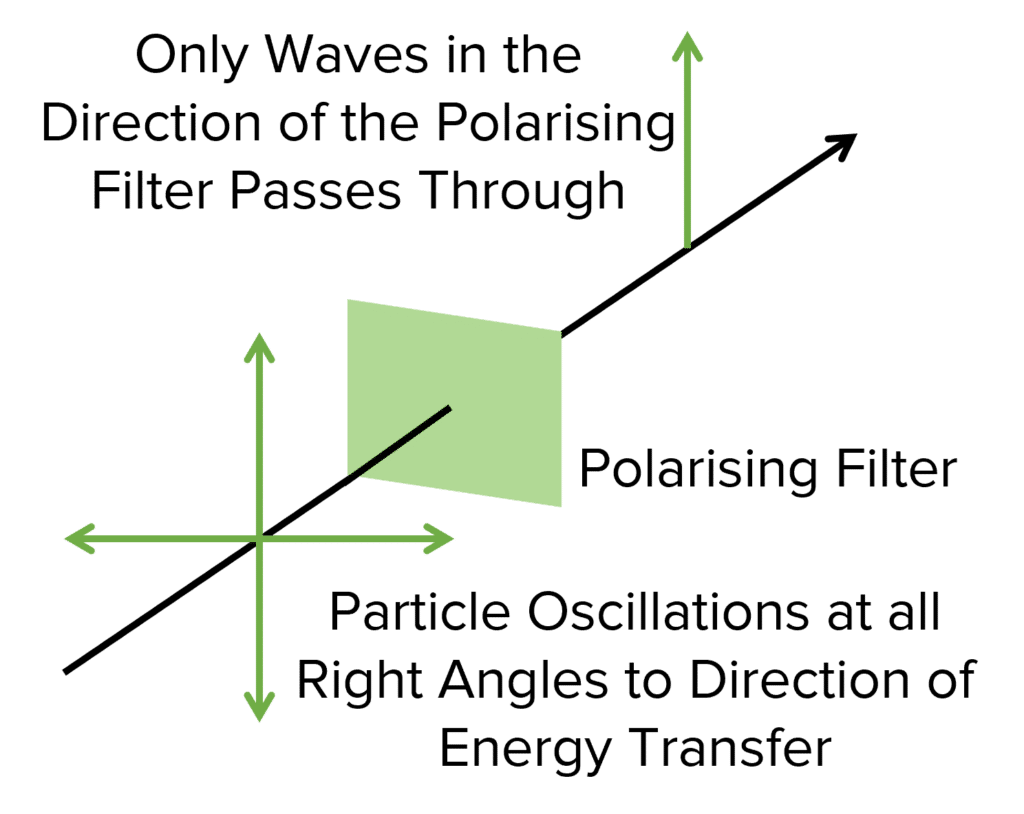Longitudinal and Transverse Waves
Longitudinal and Transverse Waves Revision
Longitudinal and Transverse Waves
Progressive waves can be split into two categories. They are either longitudinal waves or transverse waves. In this section we are going to look at the properties of each type of wave, some examples and the idea of polarisation.
Longitudinal Waves
In a longitudinal wave, the direction of oscillations and the direction of energy transfer are parallel. This can be seen in the diagram below. Each line represents a particle which is oscillating back and forth like a vibration.

A longitudinal wave consists of compressions and rarefactions. A compression is a point of higher pressure where the particles are forced closer together, whilst a rarefaction is an area of lower pressure where particles have spread further apart. As always, a wavelength is the displacement between two identical points on the wave. This could be between two neighbouring rarefactions or compressions.
Examples of longitudinal waves include:
- Sound waves
- Waves along a spring
- Ultrasound
- Infrasound
- P-waves (vibrations in the Earth as a consequence of an earthquake)
Longitudinal waves cannot be polarised.
Transverse Waves
In a transverse wave, the direction of oscillations is perpendicular to the direction of energy transfer. As previously described, transverse waves are made of a series of peaks and troughs, where one wavelength is the displacement between two identical points on the wave.

Transverse waves are more commonly found. Examples of transverse waved include:
- All the waves of the electromagnetic spectrum (radio, microwaves, infrared, light, UV, X-rays and gamma)
- Vibrations in a string (musical instruments etc..)
- Ripples in the water
Transverse waves can be polarised.
Polarisation
When observing transverse waves, we have previously looked at them in two dimensions. However, in reality a transverse wave is acting in three dimensions. Particle oscillation is always perpendicular to energy transfer but this model applies in all three dimensions.


Unpolarised waves consist of waves acting in many different planes at the same time. This can be represented in the diagram on the right:


The process of polarisation narrows all the planes down so that only one plane is allowed to pass through. This is done using a polarisation filter. The process is illustrated on the right:
This process can be combined with a second polarising filter to change the intensity of light passing through.
Once the light is polarised into one plane, if a second polarising filter is placed in the same plane as the first, 100 \% of the light will pass through both filters. However, the second filter is rotated to reduce the light intensity passing through both filters. If the filters are perpendicular to one another, no light will pass through at all.
This idea can be used in privacy screens and polarising sunglasses. TV Antennas use horizontal rods to pick up polarised signals. This is why the antennas need to be positioned carefully in the correct plane and direction to pick up a signal. The rods on the receiver must be aligned with the signal produced by the transmitter.
Longitudinal and Transverse Waves Example Questions
Question 1: Describe the similarities and differences between longitudinal and transverse waves.
[2 marks]
Any one similarity from:
- Both involve the oscillation of particles.
- Both transmit energy from one place to another.
Any one difference from:
- In longitudinal waves the oscillation is parallel to direction of wave
- In transverse waves the oscillations are perpendicular to the direction of energy transfer.
Question 2: What is the purpose of a polarisation filter?
[1 mark]
Polarisation filters light from several planes into one plane.
Question 3: Why can’t sound waves from a speaker be polarised?
[2 marks]
Sound waves are longitudinal waves.
Only transverse waves can be polarised as they act in many planes at once
You May Also Like...

MME Learning Portal
Online exams, practice questions and revision videos for every GCSE level 9-1 topic! No fees, no trial period, just totally free access to the UK’s best GCSE maths revision platform.